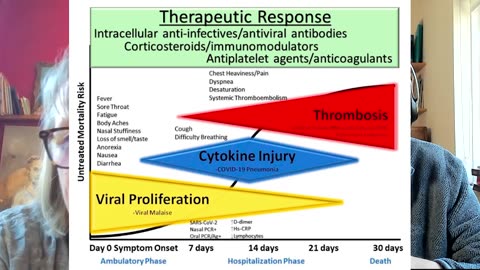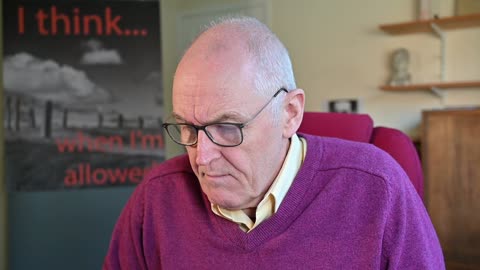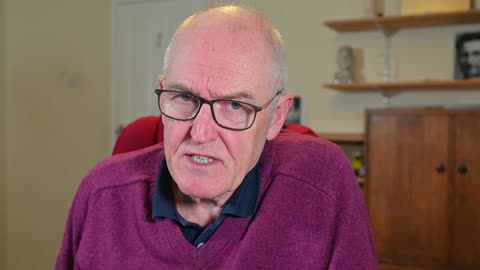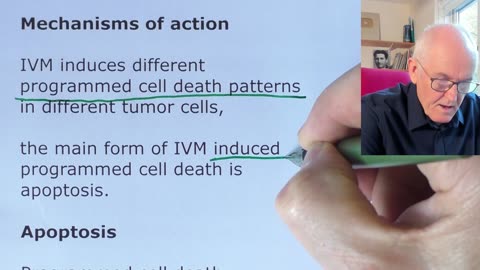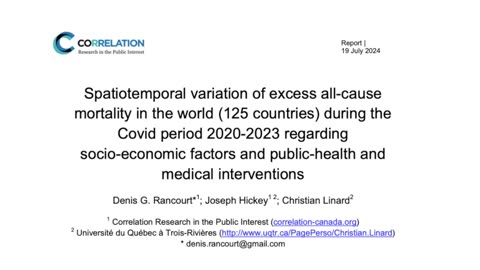Premium Only Content
This video is only available to Rumble Premium subscribers. Subscribe to
enjoy exclusive content and ad-free viewing.

Dr. Campbell
RetiredFire
- 9 / 9
1
Ivermectin treats covid
Dr. John Campbell
With Professor Colleen Aldous
Critical appraisal of multidrug therapy in the ambulatory
management of patients with COVID-19 and hypoxemia
Part II: Causal inference using the Bradford Hill criteria
https://www.jstage.jst.go.jp/article/antibiotics/78/1/78_35/_pdf/-char/en
We continue the critical appraisal of three published case series of 119 COVID-19 patients with hypoxemia, treated in the United States, Zimbabwe, and Nigeria with similar ivermectin-based multidrug treatments, to assess the available evidence supporting a causal relationship between treatment and reduction in hospitalizations and mortality. A narrative review was conducted to assess the Bradford Hill criteria for a causal association. We used a previously proposed refinement of the Bradford Hill criteria that reorganized them into three categories of direct, mechanistic, and
parallel evidence. The efficacy of the two most aggressive ivermectin-based
multidrug protocols is supported by the Bradford Hill criteria for temporality,
strength of association, biological gradient, biological plausibility, coherence, consistency, and analogy. The causal relation between the treatment of hypoxemic COVID-19 patients using these protocols and the reduction in hospitalizations and mortality is supported as an inference to the best explanation.
Critical appraisal of multidrug therapy in the ambulatory
management of patients with COVID-19 and hypoxemia
Part I. Evidence supporting the strength of association
https://faculty.utrgv.edu/eleftherios.gkioulekas/papers/032-c19-ivm-oxygen.pdf
On March 11, 2020, Coronavirus Disease 2019 (COVID-19), the disease caused by the Severe Acute Respiratory Coronavirus 2 (SARS-CoV-2), was declared a pandemic by the World Health Organization (WHO) [1]. Worldwide, 768,187,096 confirmed cases of COVID-19 and 6,945,714 deaths have been reported to the WHO as of June 21 2023, amounting to an average Case Fatality Rate (CFR) of 0.9% [2]. During 2020, while several governments and public health agencies were focused on contagion control and in-hospital patient care, several medical doctors from all around the world innovated and discovered early outpatient multidrug treatments using several repurposed medications in combination [3–15]. In the United States, several independent efforts coalesced into the formulation of a sequenced multidrug protocol [10, Fig. 3] (hereafter, McCullough protocol), which is based on the pathophysiological understanding of COVID-19 as a triphasic illness with three overlapping phases: (1) viral proliferation; (2) hyperinflammatory cytokine storm (COVID-19 pneumonia); and (3) thrombosis. McCullough’s protocol proposed a combination antiviral therapy for treating the viral proliferation phase, immunomodulators for treating the cytokine storm, and antiplatelet agents and antithrombotics for handling the thrombotic stage, based on risk stratification and how the disease presents in each individual patient. Thus, the McCullough protocol is an algorithmic treatment using sequenced multiple drugs in combination and customized to the individual patient and their response to treatment; no single drug is necessary nor sufficient to achieve treatment efficacy towards reducing hospitalizations and deaths. A recently published update of the McCullough protocol [16, Fig. 3] introduced some adjustments including virucidal nasal washes and oral gargles [17–24]. A large case series of 869 high-risk patients [25, 26], who were treated using an early version of the McCullough protocol, has been compared against population-level and historical controls [27], showing the existence of efficacy with respect to the reduction of mortality and hospitalizations, which is also resilient with respect to random selection bias, provided that patients are treated early enough within the first 3 to 5 days from the onset of illness. Indeed, an earlier study by Fazio et al.[28] showed that the ideal window of opportunity for initiating an effective early outpatient treatment of COVID-19 to prevent hospitalization is approximately within the first 3 days.
14.7K
views
70
comments
2
Fen ben for cancer ?
Dr. John Campbell
Fenbendazole Enhancing Anti-Tumor Effect: A Case Series (2021)
https://www.scitechnol.com/peer-review/fenbendazole-enhancing-antitumor-effect-a-case-series-2Kms.php?article_id=14307&fbclid=IwAR0tYpTZb4fp2_AO8e_WGWM5mcqv-RNfI-5SID9OWDcRiwHyHmQBKsjeSKk
Full PDF with radiology
https://www.scitechnol.com/peer-review/fenbendazole-enhancing-antitumor-effect-a-case-series-P3SV.pdf
Background
Fenbendazole (FBZ) is a cheap and readily available anti-parasitic commonly used in veterinary medicine.
FBZ belongs to the benzimidazole drug class which destabilize microtubules through a mechanism similar to the anti-oncogenic vinca alkaloids.
Although there are no reported cases in the literature, there have been several anecdotal stories published on website blogs with individuals praising its ability to treat a wide variety of cancers.
Case Presentations
Three patients with various genitourinary malignancies,
who demonstrated complete response after receiving FBZ therapy,
as a single or supplementary chemotherapeutic agent.
In two patient scenarios, they had experienced progression of metastatic disease despite multiple lines of therapy prior to initiation of FBZ.
No side effects from FBZ were reported.
Conclusion
FBZ appears to be a potentially safe and effective antineoplastic agent,
that can be repurposed for human use in treating genitourinary malignancies.
Further research is necessary to define the role of FBZ as a chemotherapeutic option.
Details
FBZ is a cheap anti-helminthic medication commonly used in veterinary practice,
However, despite multiple anecdotal stories and news outlet reports for its efficacy in treating metastatic cancer,
the clinical literature behind utilizing FBZ as a potential anti-neoplastic agent remains nonexistent.
Case 1
A 63-year-old Caucasian male presented with flank pain, rapid weight loss, and transient fever.
Abdominal Computed Topography (CT) revealed a 3 cm left solid renal mass.
Renal Cell Carcinoma (RCC)
Traditional drugs used then discontinued
One month after discontinuation, repeat MRI showed increase in size of recurrent left renal mass, pancreatic head and body lesion
He also started alternative therapy with FBZ 1 gm three times per week at the suggestion of one of his friends with head/neck cancer.
Interval MRI imaging found near complete resolution of the previously noted left renal mass,
as well as decrease in pancreatic head/body and pelvic bone lesion
Serial imaging for the past 10 months have not shown any evidence of recurrence or metastatic disease.
He has continued taking FBZ without any reported side effects.
Case 2
A 72-year-old caucasian male
Urethral lesion
Distal penectomy
Pathology showing high-grade urothelial carcinoma of the urethra
Four years later, the patient developed a cough,
5.5 cm × 4.0 cm left hilar mass and a left upper lobe nodule, with multiple abnormal lymph nodes
Bronchoscopy with biopsy revealed squamous carcinoma, (probable primary)
Chemotherapy given
Developed progressive retroperitoneal disease
The patient opted for complementary therapy with FBZ 1 gram orally three days per week,
vitamin E 800 mg daily,
curcumin 600 mg daily,
and CBD oil
Serial CTs from the past 9 months showed progressive decrease in size to 0.5 cm × 0.5 cm, complete radiographic response.
Case 3
A 63-year-old Caucasian female
CT imaging revealed a 7.5 cm right lateral bladder mass with extensions
Hydronephrosis requiring percutaneous nephrostomy.
Transurethral Resection of Bladder Tumor (TURBT) demonstrated a large necrotic mass,
pathology confirming urothelial carcinoma with 85% squamous and 2% sarcomatoid histology.
6 cycles over the course of 4 months,
along with concurrent FBZ 1 gram three times weekly.
Follow-up CT revealed no evidence of disease with minimal residual thickening in the right inferior bladder wall
She declined to proceed with cystectomy and remains on surveillance with no evidence of progression.
Discussion
We have three patients with different primary genitourinary tumors who demonstrated complete response after receiving FBZ therapy.
This raises the question of how effective FBZ can be as an anti-oncogenic agent and merits further investigation.
FBZ belongs to a class of microtubule-destabilizing agents
The ability to disrupt microtubule polymerization,to induce mitotic arrest,
and promote apoptosis.
? p53 activation
The variety of mechanisms by which this class of medications functions may help limit the propagation of resistant cancer cell lines
FBZ has been safely utilized as an anti-parasitic for various different animal species and could be repurposed for treating human malignancies.
Several benzimidazoles have already shown promise for human repurposing.
Mebendazole has been shown in case reports to be efficacious with few side effects in patients with metastatic adrenocortical carcinoma and metastatic colon cancer
Mebendazole, effective in animal studies for glioblastoma
Flubendazole, animal studies, hematologic malignancies
Given evidence of high tolerability and applicability to a wide range of malignancies,
this warrants further investigation for FBZ and other benzimidazoles as safe chemotherapeutic options.
Conclusion
There remains limited data with few published studies on the anti-oncogenic properties of FBZ.
Other benzimidazoles have been studied to a larger extent,
and the knowledge can be drawn upon to help guide future FBZ studies,
and to gauge the efficacy of this drug class whether as a solitary agent or in combination therapy.
Given the potential benefits of FBZ with what seems to be a limited toxicity profile,
further research is warranted to evaluate the clinical settings in which this medication may be beneficial and repurposed,
for patients with progressive genitourinary malignancy and possibly in other malignant settings as well.
35.8K
views
261
comments
3
New vitamin D paper
Dr. John Campbell
Vitamin D: A key player in COVID‐19 immunity and lessons from the pandemic to combat immune‐evasive variants
https://link.springer.com/article/10.1007/s10787-024-01578-w
As of July 2024
775,754,322 confirmed cases of COVID-19
13,578,710,228 vaccine doses had been administered
It is unclear why some patients develop severe symptoms while others do not,
literature suggests a role for vitamin D.
Vitamin D plays a crucial role in the infection or in ameliorating the severity of symptoms.
VDD is associated with increased hospitalization of severely ill patients and increased levels of COVID-19-caused mortality.
The mechanism of action of vitamin D and vitamin D deficiency (VDD) is well understood.
Vitamin D levels and genetic variations in the vitamin D receptor (VDR) gene significantly impact the severity and out- comes of COVID-19,
especially in the infections caused by Delta and Omicron variants.
Furthermore, VDD causes immune system dysregulation upon infection with SARS-CoV-2,
indicating that vitamin D sufficiency is crucial in fighting against COVID-19 infection.
Potential role as a prophylactic and treatment adjunct.
Immunomodulatory and anti-inflammatory effects of vitamin D
Ability to enhance the efficacy of new antiviral drugs
Large- scale randomized trials are required to reach a definitive conclusion.
Mechanisms of action
Macrophages activated to produce defensive proteins and stimulate naïve T cells
Activate T lymphocytes and mature B lymphocytes into plasma cells
Prevents inflammation, vasoconstriction, and fibrosis of the lungs.
Prevents excess release of cytokines from macrophages
Prevents excessive CRP production in the liver
Vit D can reduce viral replication
Vitamin D can protect against ARDS, the main death-causing complication of COVID-19
Seven out of nine studies reviewed by Yisak
https://pubmed.ncbi.nlm.nih.gov/33447107/
have indicated a crucial role in vitamin D status in COVID-19 infection, prognosis, and mortality.
Vitamin D dose
To decrease the risk of contracting a new infection,
people at high risk of COVID-19 to take 10,000 IU d−1 of vitamin D for a few weeks,
followed by 5000 IU d−1 to raise the concentrations of the active form of vitamin D.
Blood levels
Levels below 12 ng/mL indicate severe deficiency.
Levels between 12 and 20 ng/mL suggest deficiency
Treatment recommended for levels below 30 ng/mL
Optimal levels are 30–60 ng/mL,
Recommended prophylactic dose
0–1 years, 400 IU/day (10 mcg)
> 1 year, 600 IU (15 mcg)
> 8 years, half an adult dose
Adults, 800– 2000 IU of cholecalciferol
Routine toxicity monitoring is unnecessary for doses under 10,000 IU/day
24.5K
views
297
comments
4
I see my cardiologist
Dr. John Campbell
Link for the full film First do no Pharm, https://cerealkillers.gumroad.com/l/nopharmfilm/drjohn
This is film isn't just an exposé – it's a call to arms. It will provide you with the knowledge and tools to fight back against a system that values profits over patients. We'll show you how to navigate this treacherous landscape, how to protect yourself and your loved ones from the excesses of an industry gone mad.
Email for Dr. Malhotra consultations
concierge@hum2n.com
21.7K
views
77
comments
5
Ivermectin and cancer
Dr. John Campbell
Ivermectin, a potential anticancer drug derived from an antiparasitic drug
https://www.ncbi.nlm.nih.gov/pmc/articles/PMC7505114/
Mechanisms of action
IVM induces different programmed cell death patterns in different tumor cells,
the main form of IVM induced programmed cell death is apoptosis.
Apoptosis
Programmed cell death
Autophagy
Lysosomal-dependent form of programmed cell death.
Pyroptosis
Inflammatory cell death induced by inflammasomes.
Kathleen T Ruddy, MD
https://twitter.com/bobanderson77/status/1797002359521866017/video/1
https://rumble.com/v4vk4pw-oncologist-kathleen-rudy-reveals-horse-dewormer-aka-ivermectin-cure-cancer.html
https://twitter.com/DocRuddy
https://rumble.com/v4vk4pw-oncologist-kathleen-rudy-reveals-horse-dewormer-aka-ivermectin-cure-cancer.html
Forms of cancer
Breast cancer
A malignant tumor produced by gene mutation in breast epithelial cells
Digestive system cancer
Gastric cancer is one of the most common malignant tumors worldwide.
Hepatocellular carcinoma is the fourth leading cause of cancer death worldwide.
Urinary system cancer
Renal cell carcinoma is a fatal malignant tumor of the urinary system derived from renal tubular epithelial cells.
Prostate cancer is a malignant tumor derived from prostate epithelial cells
Hematological cancer
Leukemia is a type of malignant clonal disease caused by abnormal hematopoietic stem cells
Reproductive system cancer
Cervical cancer is one of the most common gynecological malignancies
Ovarian cancer is a malignant cancer that lacks early clinical symptoms and has a poor therapeutic response.
Brain glioma
Glioma is the most common cerebral tumor
Glioblastoma, median survival time of 14-17 months
Respiratory system cancer
Nasopharyngeal carcinoma is a malignant tumor derived from epithelial cells of the nasopharyngeal mucosa.
Lung cancer has the highest morbidity and mortality among cancers
Melanoma
The most common malignant skin tumor with a high mortality rate.
Other papers
Ivermectin suppresses tumour growth and metastasis through degradation of PAK1 in oesophageal squamous cell carcinoma
https://www.ncbi.nlm.nih.gov/pmc/articles/PMC7205794/
Antitumor effects of ivermectin at clinically feasible concentrations support its clinical development as a repositioned cancer drug
https://pubmed.ncbi.nlm.nih.gov/32474842/
Ivermectin converts cold tumors hot and synergizes with immune checkpoint blockade for treatment of breast cancer
https://www.nature.com/articles/s41523-021-00229-5
Abstract 2320: Ivermectin suppresses pancreatic cancer via mitochondria dysfunction
https://aacrjournals.org/cancerres/article/82/12_Supplement/2320/701043/Abstract-2320-Ivermectin-suppresses-pancreatic
Video reviews
https://www.youtube.com/watch?v=vCgNaOvICsk
https://www.youtube.com/@dr.kathleenruddy1734/videos
https://www.youtube.com/watch?v=m_78xfHRHUY
https://www.youtube.com/watch?v=jaY2BeNnfy8
34.5K
views
472
comments
6
Report from Capital Hill
Dr. John Campbell
Link for the full film, https://cerealkillers.gumroad.com/l/nopharmfilm/drjohn
Th First do no Pharm
This is film isn't just an exposé – it's a call to arms. It will provide you with the knowledge and tools to fight back against a system that values profits over patients.
We'll show you how to navigate this treacherous landscape, how to protect yourself and your loved ones from the excesses of an industry gone mad.
27.7K
views
175
comments
7
Global excess deaths
Dr. John Campbell
Spatiotemporal variation of excess all-cause mortality, in the world (125 countries), during the Covid period 2020-2023,
regarding socio economic factors,
and public-health and medical interventions
https://correlation-canada.org/covid-excess-mortality-125-countries/
https://www.worldtribune.com/researchers-study-of-125-countries-finds-no-evidence-covid-vaccines-provided-any-benefit/
34.9K
views
117
comments
8
Severe vaccine injury
Loading 345 comments...
-
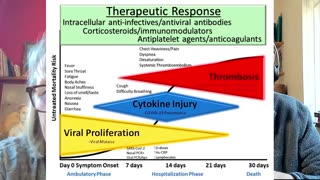 1:05:04
1:05:04
Dr. John Campbell
1 day agoIvermectin treats covid
14.7K70 -
 1:15:29
1:15:29
Dear America
14 hours agoAustin Metcalf Killer RELEASED, JD Vance Fumbles CFP Trophy + CNN Gets Bullied In The Oval Office!
34.9K14 -
 LIVE
LIVE
Major League Fishing
23 hours agoLIVE Tackle Warehouse Invitationals, Stop 3, Day 1
746 watching -
 55:17
55:17
2 MIKES LIVE
1 hour agoTHE MIKE SCHWARTZ SHOW with DR. MICHAEL J SCHWARTZ 04-15-2025
6.51K -
 1:19:29
1:19:29
Game On!
14 hours ago $4.56 earned8,000 Subscriber Celebration Stream!
40.3K1 -
 28:30
28:30
Degenerate Jay
16 hours ago $4.36 earnedThe Rejected 007 Quantum Of Solace Ending That Would Have Changed James Bond
56.5K6 -
 11:37
11:37
ARFCOM Reviews
15 hours ago $2.50 earnedNew Budget Comp'd Carry || Canik MC9 PRIME
41.1K4 -
 8:22
8:22
Rethinking the Dollar
18 hours agoSilver vs CBDCs: The Battle for Financial Freedom
37.8K6 -
 55:15
55:15
MTNTOUGH Fitness Lab
19 hours agoTJ Dillashaw: Embracing Fear as a Privilege | MTNPOD #112
29.8K2 -
 12:24
12:24
T-SPLY
1 day agoKamala’s COMEBACK FLOPS as Dems DITCH Her!
26.7K13
